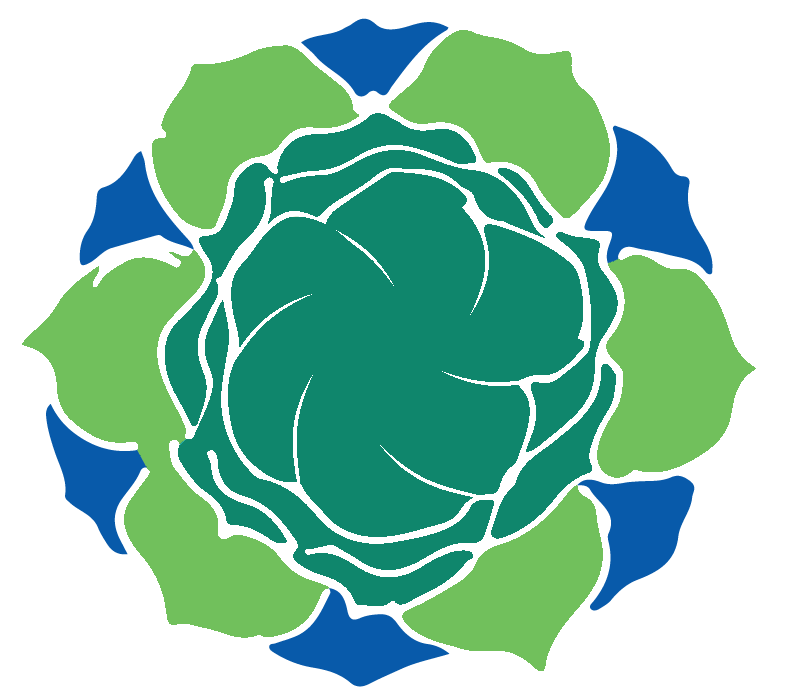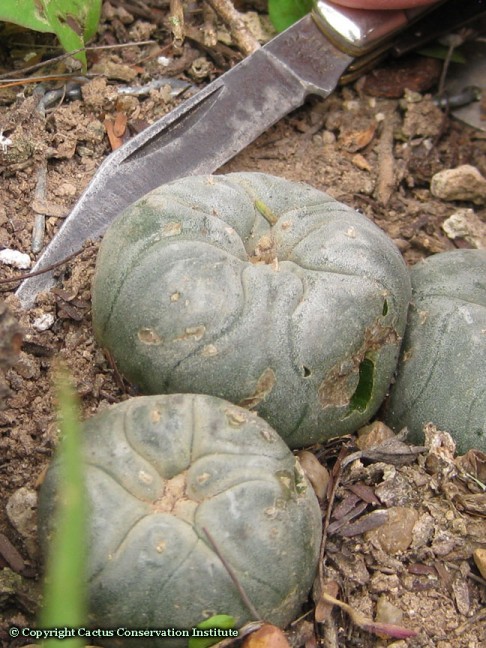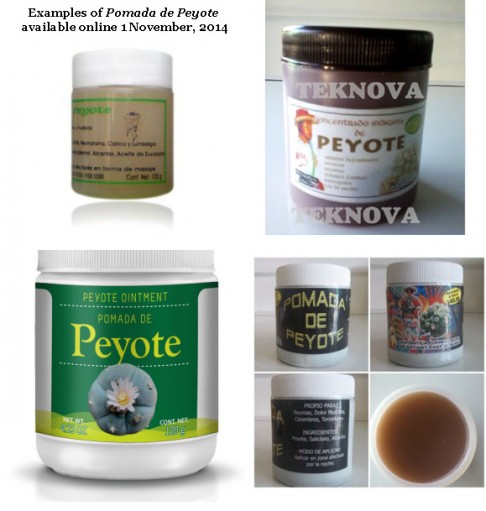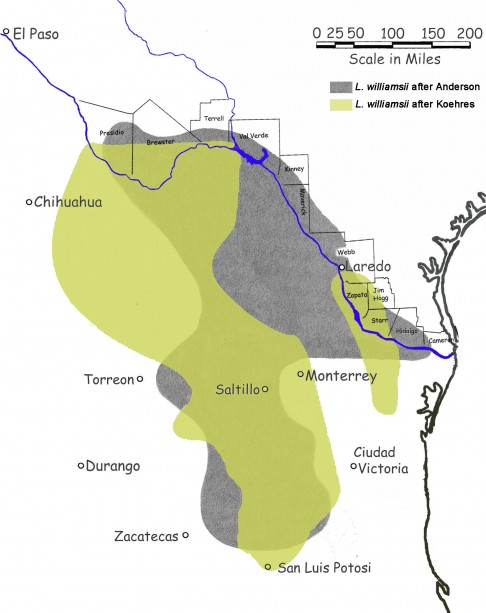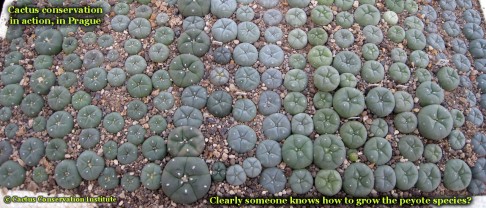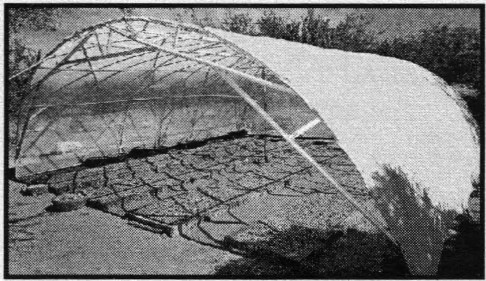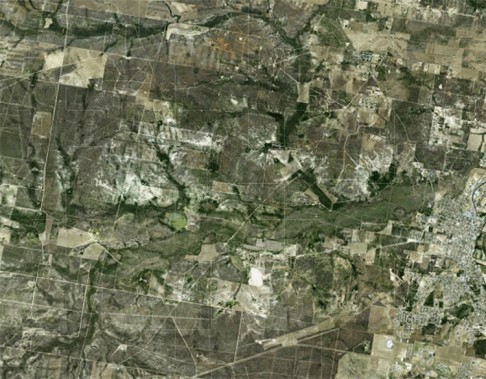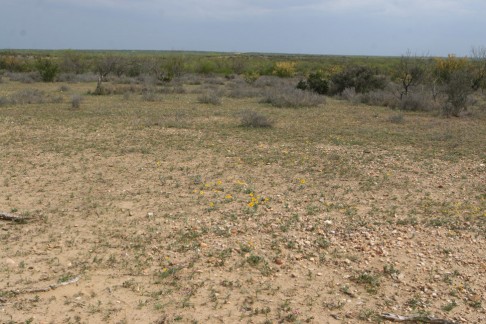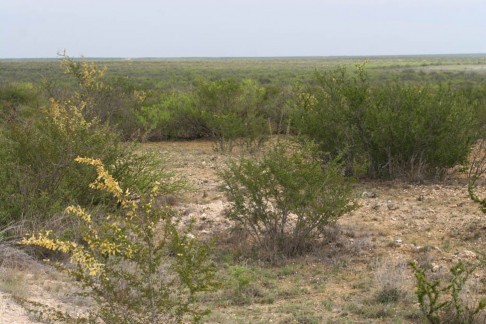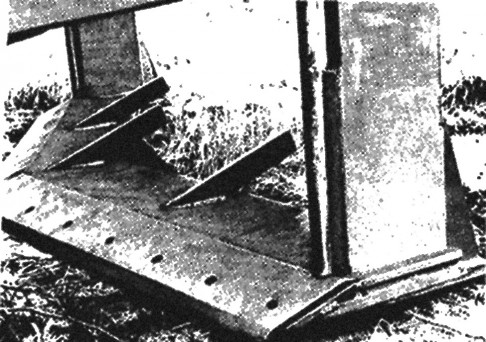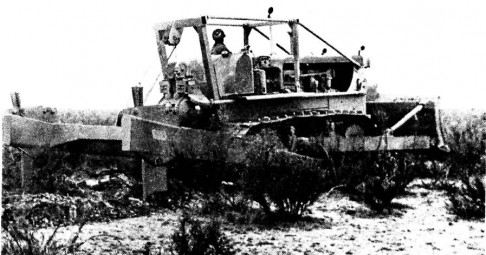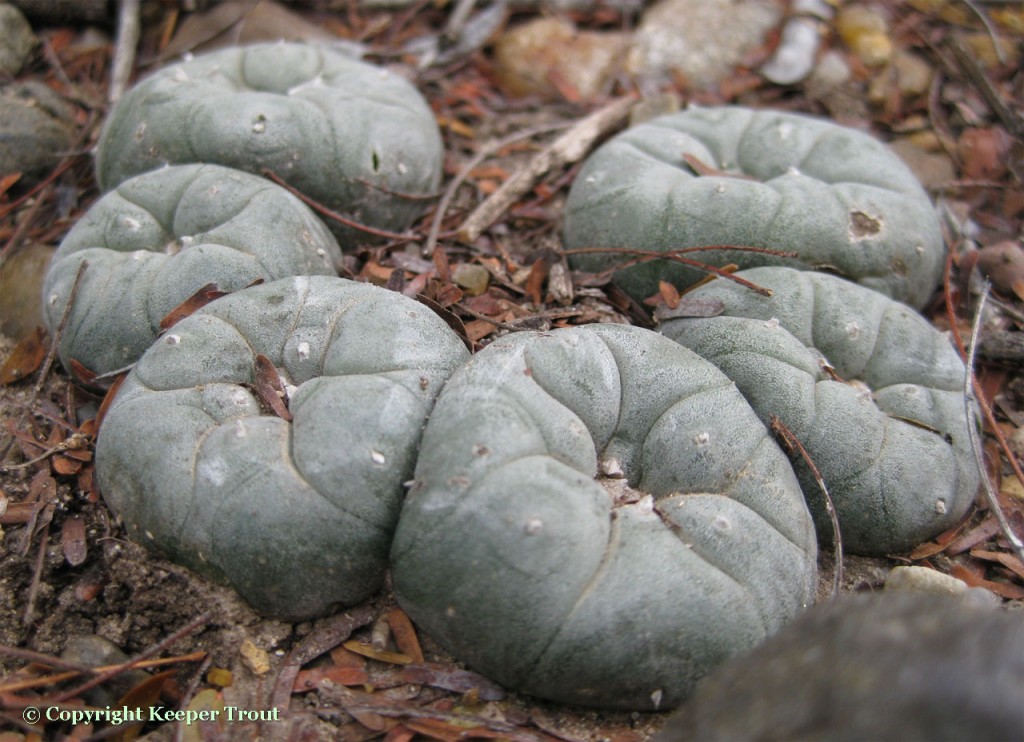The Peyote Crisis Revisited
It appears to be a ripe time for reevaluating the article entitled “the Peyote crisis & some suggestions“.
This was variously positioned as Chapter 2 or Chapter 3 in the revisions of the book Sacred Cacti.
That chapter, as written, is greatly in need of revision & updating; and some additional questions being asked about *its* suggestions. Our use of the word “I” in this article simply means we want to say this with one voice. Use of the word “we” refers to the reader and ourselves.
This commentary, as written, is meant to serve the great need for better accurate public education and has been constructed primarily for clarity of presentation of the contained material. It has not been created with the same density of in-line references such as would be the case for a work that was intended for print publication in a peer reviewed journal. It is hoped that adequate documentation and references are included for the benefit of people wanting to learn more but if YOU want to learn more or need any additional clarification or supportive documentation please drop an email to keepertrout at gmail and ask.
Accompanying this information is the feeling that there is some urgency in it being released. It is therefore being made available for public inspection and comment without further delay. The plants of tomorrow begin with the seeds that are planted today.
Commentary & thoughts by Keeper Trout, Blake Edwards & Martin Terry
“I also went to survey the gardens in February [1998]. The situation is sad, intolerable, several parcels hunted completely clean. On inquiring with the dealers, I was able to hand sort well over 10,000 dime sizers, most w/roots. They are picked that way because the payment is per unit. […] those 10,000 plus babies are now growing. My idea is to purchase all the babies we can for their eventual re-planting in Texas.” Leo Mercado 6 July 1998 (personal communication).
Those same plants were later seized (as part of a dump-truck load containing more than 11,230 living peyote plants) and destroyed by a “multijurisdictional task-force” of law enforcement officials despite Leo at that time having been found in court to be in compliance with Arizona state law permitting the sincere religious use of peyote. In the aftermath of what can only legitimately be described as a terroristic home invasion, Leo posted a notice online that he had replanted the 200 or so peyote plants that had been missed or dropped during the raid. No charges were filed, which fact was likely to prevent a return of his peyote as had occurred after the first time that they seized Leo’s peyote. Instead Leo’s landlord found himself being threatened with the seizure and forfeiture of his property if he did not evict Leo and his family. The basis of that threat was his supposedly renting to a “known illegal drug dealer”, namely Leo!
Apparently Leo’s living example as a human of only modest means successfully propagating and cultivating large numbers of peyote plants outside of Texas was too powerful of an example to be allowed to exist. At the very least, his Kearny, Arizona shade-house and gardens had to be seen as an awkward truth running counter to the lies propagated about it being impossible to grow peyote outside of its native habitat.
From Ch. 3 in Sacred Cacti 3rd edition (with some edits).
Cutting crowns flush at the level of the ground has been established to be the best known harvesting technique for peyote. This approach to enable sustainable harvesting has been known of and employed by peyote consumers in Mexico for millenia. The archaeological peyote specimens discovered strung on a cord at Cuatro Cienegas are more than a thousand years old; the Shumla peyote effigies are over six thousand years old.
First, concerning the “crisis”….
One suggestion, really, is all that is required; assuming that it can be heard, without prejudice, where it matters.
Cultivate the Medicine.
It is really simple yet that simple truth of the matter has been almost completely buried, if not forgotten or deliberately obscured, in rhetoric that has at times variously been self-serving, manipulative, deceptive, disingenuous, confused, based on misunderstandings, culturally bigoted, or sometimes even entirely delusional. There really was not any delicate way to put that so I apologize for trodding on anyone’s conceptual toes.
Some people might ask: If peyote is a pressured species, why isn’t it cultivated?
The question, “why isn’t it cultivated?” is a really good one. You and I will be exploring its answers in some detail.
We should start by clarifying some things and being certain that we all have a good grasp of an unnecessarily convoluted story.
The conservation status of peyote
Peyote is most certainly not extinct as some people strangely seem to believe and are even willing to say openly as if it were a fact. It is not yet really even an endangered species as more than a million living peyote crowns were no doubt harvested in South Texas again this past year by the licensed peyote distributors (I have to say probably as the numbers are not yet available).
A perception that the pressure from peyote harvesting is endangering the species is nothing new. While it does not appear on any federal listing of endangered species, peyote WAS declared an endangered species by the Texas Organization of Endangered Species (TOES) according to Morgan 1983: 83-84. Despite having a long history of cost sharing with land owners for brush removal and clearing of land, since the late 1970’s the U.S. Soil Conservation Service has refused to do so in any area containing peyote, as the SCS recognizes it to be a potentially endangered member of Texas flora (Morgan 1984: 292). Their lack of financial contribution has not slowed the clearing of land in the development of South Texas.
Only recently was peyote actually finally recognized as having adequately dwindling numbers to merit being assigned a status of “vulnerable” and being placed on the IUCN Red List of Threatened Species. Version 2013.2.
Debates as to whether it should or should not be placed on the Red List had been going back and forth for some years, Oddly, what seems to have tipped the balance of opinion was the appearance of cosmetic/pharmaceutical industry products known as Pomada de Peyote. I’m not including these links to suggest that any should be patronized but simply to note what came up in a Google search for “pomada de peyote” on 1 November, 2014. Here are images of five of the products that were found to be offered on the first search results page.
It is certain that as both a liniment and an ointment, similar formulations have existed for a very long time at the folk level, and more recently as products of a local cottage industry. These products have likely achieved visibility only when the distribution venue was moved from local yerbarias to online marketing.
” The use of peyote is traditional among some Hispanics in South Texas, too.
“When I was younger, you could buy it at the market in Nuevo Laredo, or at any of the local yerberias (herb shops),” [Salvador] Johnson said.
His wife, Vicenta, said that elderly Hispanics still use the drug as a cure for a variety of ailments, including as a rubbing lotion to treat arthritis when it is mixed with alcohol.“
Grant 2000 Ft. Worth Star-Telegram, Sunday, 23 January.
One of the companies now producing pomada de peyote is an established business that is substantial in size and has previously developed other successful product lines. The future development of this product will be interesting to watch. It may be noteworthy that the number of different producers showing up as hits on the first Google search result page went from two to five within the past year.
Peyote is not endangered as a species for a variety of reasons. The most notable being that there are large expanses of the Mexican peyote populations left. The secondary reason is that not all peyote is accessible for harvest. In some cases, harvests are deterred by a lack of road access but in at least one instance a local population (in Mexico) is protected by the resident humans who interestingly do not use their local peyote for any purposes other than as an external analgesic applied to burns, bruises and aching muscles & joints.
In Texas it is a different story. The vast majority of its peyote populations have long since been removed during the course of the modern-day occupation/development of South Texas real estate and the collateral development of its assorted resources. Some peyote finds protection on large ranches with tall fences designed to retain game animals that are hunted for a hefty fee. When the owners of such large tracts of brush also do not permit peyote harvesters to access their land those properties form unintentional peyote reserves. The land that is left as accessible is heavily impacted by the existing peyote trade. In addition, the commercial peyote harvest has been insufficient for meeting NAC needs for some time.
There are two distinct but inseparable subtopics within this main topic of the threats to peyote, whether those threats are due to habitat loss or over-harvesting or any of the other known challenges that peyote faces.
One is the future of peyote as a species and the other is the future of the NAC as a Medicine-based spiritual organization that has both adequate and uninterrupted access to its Medicine.
We will examine both of those subtopics separately as this overview unfolds.
Some statistics from the Texas Department of Public Safety (DPS)
Peyote Buttons Sold
The above reflects the reported activities of the licensed distributors (and their employees) based on figures provided by the Texas Department of Public Safety (DPS).
There are presently three peyote distributors and this has been true since 2006. Four licensed peyote dealers were still in operation in 2003-2005. Prior to that there were five and before that there were more. I have heard that a fourth has submitted his paperwork to DPS. It appears to be a relative of one of the existing distributors who is growing older and facing retirement in the future.
It is an interesting point of clarity that the licensed distributors who sell peyote prefer to be called “peyote dealers” rather than peyoteros. Math in the fourth column is mine so any mistakes there are mine.
The late 1990s is when the average size plummeted for the buttons showing up in NAC meetings in central Texas. In the late 1990s sacks of Mexican peyote became more common.
It is very easy to see that a lot more peyote populations exist in Mexico than are inside of the USA.
The distribution of Lophophora williamsii
The suggested distribution of peyote Composite map created from Anderson 1980 & Koehres
Concerning this map:
It is important to be aware that peyote grows only in soils that are acceptable to it. This is true within any region it occurs, and therefore this map suggests there is a far more substantial distribution and many more populations than really exist (or have ever existed) within the shaded zones.
Anderson created this map by placing the reported herbarium collections, some of which are now known to be erroneous, as dots on a map and then drawing a line encircling them all.
For those reasons reason it is extremely doubtful that any peyote actually lives within large sections of the indicated areas. To put it another way, the presence of a solidly shaded area does not imply a continuous peyote population anywhere within it. It certainly does not indicate a lawn of Lophophora.
Koehres created his map similarly but incorporates his own field information which is superior to that of Anderson.
How difficult is peyote to grow?
It is easy to find it said that peyote is difficult or even impossible to grow.
After interviewing peyoteros in 1988 John Morthland wrote,
“Indeed, peyote is almost impossible to cultivate. Once a seed germinates, the plant takes five years to grow big enough for picking, and the root of a harvested peyote takes nearly that long to bloom again.“
Morthland’s “almost impossible” estimates are actually optimistic despite being shorter than reality. A professional cactus cultivator would consider them to be more typical than impossible and would simply take those numbers in stride in his or her production planning.
The reality is that peyote is among the easiest and the most forgiving of the cactus species to grow from seed.
Peyote, like any other cactus species, is fairly slow growing which is why what is developing contains the elements of a crisis-in-the-making. After cultivation begins in a meaningful way, more than a decade can be expected to elapse prior to the first acceptable harvest.
The widely circulated meme that cultivation is somehow a difficult challenge is probably just simple propaganda that conveniently serves licensed distributors, law enforcement and the powers-that-be alike.
Cactus cultivators have not reported similar results as the image of what is largely Lophophora diffusa in the next photograph should illustrate. These seedlings shown below are growing in Prague.
It is also surprisingly common to find it said that peyote cannot be cultivated anywhere outside of its natural ranges. People like Leo Mercado who, in theory, have proved this to be in error have actually proven just how right Voltaire was when saying:
“It is dangerous to be right in matters on which the established authorities are wrong.”
At least, we now understand WHY peyote cultivation is considered to be impossible: not because of any technical issues but rather because the federal, state and/or local police will come and destroy the peyote plants if they learn of their existence.
Leo’s “impossible” shade house in 1998.
Taken with Leo’s permission from their newsletter
That is only the beginning of this story as it is clear that the cultivation of peyote is easy.
Cultivation of someone else’s spiritual sacrament, however, rapidly becomes a quite different subject altogether.
The one very significant hurdle for the cultivation of peyote is a lack of acceptance by more than a relatively few members of the NAC.
This will be explored in more detail when this commentary continues.
What has happened to create dwindling peyote populations?
Reading the popular press or listening to people talk, one would think that overharvesting by Native Americans or “hippies” is the cause. One or the other or both typically gets the most common and most vocal blame. This is true, despite it being absolutely clear that the vast majority of peyote’s obliteration, both in terms of absolute numbers and in total acreage, has actually been the incidental destruction of populations during the process of land conversion. All other factors combined pale by comparison.
There have been many reasons for this; the development of land for various projects, such as construction projects, shopping centers, parking lots and tract communities, or as a result of the brush suppression methods that enable ranchers to use their land for agriculture or ranching. Once a piece of land has been converted, peyote does not return.
Aerial view of a portion of the Peyote Gardens in Starr County showing extent of the land use and clearing. Photo clipping came from a topographic map from the US Geological Survey (USGS).
Most of peyote’s habitat in South Texas is covered with a tangle of dense thorny brush. To make their land available for agriculture or cattle, it was once a common practice for landowners to root-plow the soil due to the tendency of the thorny brush to come back with an aggressive vigor after being cleared. Root-plowing severs the roots below the soil surface thereby weakening whatever of the roots can’t be uprooted and suppressing their ability for good regrowth. Or at least suppressing it for longer than might be the case without it. Repeating the process a few times does help but it is noteworthy that what actually becomes most suppressed is the diversity of life while the actual species that were attempted to be eradicated often go on to become the predominate vegetation.
Land in Maverick County that was root plowed several decades ago. The ranch foreman claimed that peyote was here before that occurred. Their most likely intended target for eradication was the Acacia rigidula which comprises about a third of the plants seen in the lower image above.
Root-plowing has been determined to have lasting adverse impacts when used in dry regions. In arid environments with abundant limestone, in this case it is present as a calcareous gravel, rainwater dissolves the carbonates and other soluble ions but there is insufficient volume of water to carry what is dissolved more than a fairly short distance into the earth, accumulating and eventually creating a bed of ‘caliche’ at the depth of maximum moisture penetration. Due to rainfall being variable in the total amounts delivered per storm, this eventually forms an irregular gradient of alkali concentrations existing between the caliche and the surface ; with the surface obviously being the most life friendly. The layer of decomposing organic materials at or near the surface adds to the ability of the soil to support life. This natural zoning develops over long periods of time with whatever level of moisture they DO have accessible. As it becomes increasingly basic with increasing depth this also means that that the surface is most amenable to supporting life. Accompanying that is the observation that, as rains moved part of the soluble alkali into the earth, that action helps make the surface more life friendly. This fragile balance becomes completely undone with the mixing of the top half meter of soil during root plowing. In this process, the more basic material that has been migrating away from the surface is partially returned to the surface during the mixing process. Recovery is typically slow since the reduction of the alkalinity at the surface level relies on repeated water percolation over time. The resulting increase of surface alkalinity leads to a die-off of small cover plants following seed germination and adds prolonged difficulty in reestablishing the normal flora. In adjacent areas that are used for agriculture due to being more sandy loamy than gravelly, and additionally due to the topography of the land being flatter & less sloping, this creates problems with blowing dust.
As a result root-plowing is now discouraged for those soil types and when it becomes needed specialized implements are used to selectively remove single plants. The important thing to understand about root-plowing is that unlike the thorny brush that the root-plowing is intended to eradicate, a single thorough root-plowing will generally permanently exterminate all of the existing peyote on that a given piece of land. If you want to gain a really solid grasp of this technology and a better understanding about why it would impact peyote so adversely, visit http://YouTube.com and search for “root plow” or “rootplowing”. Nothing describes the process better than watching a root-plow in action.
Other brush-clearing methods are not less destructive to peyote but they do impact the soil and ability of the land to recover less than root-plowing. YouTube can provide looks at modern techniques of “brush clearing in South Texas” as well.
Root plow
Those fins are designed to force the severed roots to the soil surface and into the sun to dry and die.
“ The root plow is a tool for removing vegetation by cutting it below the soil surface […] killing brush and light vegetation by undercutting it […] at depth from 20 to 50 centimeters (8-20 inches). […] The advantage of the root plow is that it cuts the vegetation below the bud ring, killing brush that would normally resprout if cut at ground level.” US Army 1974 Tactical Land Clearing, p. 3-6
Trunnion-mounted root-plow in action.
Both scanned photos came from a 1974 US Army training manual entitled “Tactical Land Clearing”.
A new threat to peyote in South Texas are windfarms which choose the highest points in the Bordas Escarpment for their placement. These of course need an access road permitting both construction and maintenance. Those roads potentially carve through some of what few undisturbed peyote populations still remain in South Texas.
What do we actually know about the harvesting of peyote?
Surprisingly little study has been done on the impact of harvesting itself. As far as I am aware, only one organization, a nonprofit group named the Cactus Conservation Institute, has taken the time to learn more despite the immense need for this information as regards both the NAC and peyote conservation. It is clear that the peyote plant is a resilient species or it never could have permitted mass harvests to continue for so many years in the face of diminishing habitat. There are many articles that are available concerning the harvesting of the peyote plant and about its habits and habitat.
It IS known that the best way to cut peyote is at ground level. Cutting too deeply increases mortality and weakens those plants which do manage to recover.
The one existing study on the subject was published in Terry & Mauseth 2006. Using a histological evaluation, it was established that only the stem tissue was capable of producing new growth. Root tissue could only grow roots. A visible clear and sharp line of division was noted to exist between the two tissues.
Peyote harvesters often use a shovel with sharpened edge or a machete. Both of those tools can work great for cutting at ground level or they can be mis-employed and produce a deeply angled cut.
What do we know about the impact of peyote harvesting on wild populations?
A simple overview:
More complete details concerning the items in this list can be gleaned at the Cactus Conservation Institute website or in Kalam et al. 2013, Klein et al. 2015 (in press), Terry et al 2011, 2012, 2013 & 2014.
1) Peyote harvest causes a small increase in mortality.
2) If harvesting is repeated too frequently, this rate of mortality increases.
3) Harvesting also reduces the amount of harvestable biomass of sacrament per plant.
4) The aforementioned observation (3) is initially obscured by the increase in numbers due to the common occurrence of multiple regrowth. However, the sum total biomass of head (crown) tissue per plant, even after 4 years of uninterrupted regrowth, was still significantly smaller than the biomass of the original single head that had been harvested four years before. The study to determine the minimum sustainable recovery period after harvesting is still not complete, but it now clear that the time required for recovery from a single harvesting event is greater than six years.
5) Analysis has also shown that even after four years the regrowth had regained only half the potency of the original crown. It is not yet known how long it takes for the original potency to be re-established in the regrowth buttons.
6) Current and future seed production contributions to the local population are lost along with the harvested plants. The typical fate for peyote seeds following a harvest is into the trash or compost. During the late 1990s, Leo Mercado was able to successfully recover (and plant) many thousands of seeds from the piles of hairs and tufts that accumulated from the peyote cleaned in preparation for a large ceremony. That event, at an annual NAC meeting at Mirando City, consumed more than a thousand crowns. (Information from a personal communication with Leo in 1998.)
7) The oldest and largest plants have been selected for by their environment as those are the plants which are best suited to survive the peak adverse periods of weather. These are commonly preferentially harvested – precluding any future contribution they might have made to the genetics of the population. This last point may be subtle but played out over a long time can become significant. Following the removal of these genetically superior products of natural selection, future adverse periods of weather will likely begin to produce an increased adverse impact on the remaining population.
Peyote plant with multiple regrowth
Recovery
Let’s go over through that overview again but this time from a slightly different angle of thought and consider those factors in terms of recovery.
Recovery after harvesting is a core concept for this subject as it interweaves an impact assessment with a determination of sustainability. If the harvesting of a natural renewable resource is not sustainable, both harvesting and availability are temporary and transient phenomena with an inevitable end point involving either the loss or increased scarcity of that resource.
There is nothing mysterious or unclear about what is being witnessed. A dramatic multiplication of undersized individuals is in fact the classical model resulting from harvesting activities involving an overexploited natural resource, be it fish or ginseng roots. (See Terry & Trout 2013. This link is a PDF file.)Recovery is best understood not by looking at recovery of the individuals which are involved but of the health of local populations which are composed of many individuals.Recovery of a population will accordingly have several factors based on what we looked at in our overview:
